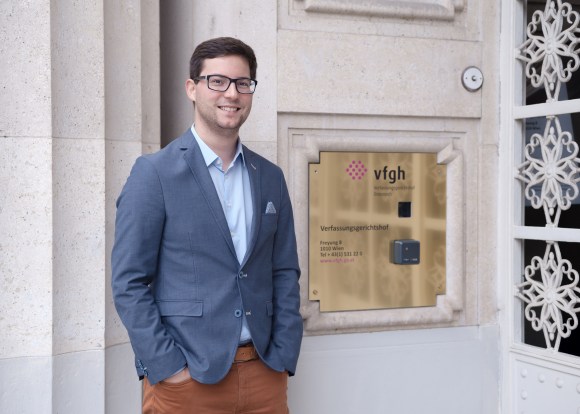
As with many things in life, it can pay to look at things from a new perspective. This holds true for the Wikimedia community’s commitment in the GLAM area—galleries, libraries, archives and museums. It is not that prior GLAM cooperation initiatives have not been successful or have taken an unsatisfactory turn—quite the contrary, in fact. But at some point in every successful project comes the time when one should look beyond and explore new ground.
In the case of GLAM, I took the plunge last summer. For the first time ever, an institution outside of the cultural area had the confidence to recruit a Wikipedian in residence, to open up its holdings to them, and to work with them to toward fostering an understanding of free knowledge. Significantly, this institution was not one that depends on public visibility, but was instead one whose sense of discretion and reliability sets standards and constitutes an essential element of its fundamental mission: the Austrian Constitutional Court.
The Constitutional Court of the Republic of Austria is one of the three high courts in Austria and the only court in the country exercising constitutional jurisdiction; as public institution that pronounces final highest court judgments, it is comparable to the US Supreme Court or the Federal Constitutional Court of Germany. Its findings have often helped write Austrian contemporary history. The court recently made international headlines when it annulled the results of the presidential election in Austria in summer 2016, just before I began as their Wikipedian in residence.
How does an institution like this fit into a concept that encourages free access to knowledge?
As described before, one of the essential features defining a court—at least according to our Central European understanding—is that the parties to the proceedings are assured discretion. At the same time, or as a result thereof, the public places the greatest trust in this institution, something that applies all the more to a high court, because its assessments cannot be further challenged and its judgment is final. As a rule, such courts do not have a lot of latitude when it comes to commenting on current proceedings or even allowing outsiders access to files and documents.
This is precisely what makes the work of a Wikipedian in residence at such an institution particularly interesting: determining whether documents and files can be made accessible is like a treasure hunt on uncharted land. But thanks to the wonderful support of Dr. Josef Pauser, the Head of the Library of the Austrian Constitutional Court, the success of this search was extraordinary and unearthed some gems, the further use of which promises to become highly interesting. These include, for example, pictures of all of the current constitutional judges and of the past members of the Constitutional Court; and files and books pertaining to long-concluded historically or jurisprudentially interesting proceedings from the 1920s, no longer subject to privacy or archiving rules. In particular, the history of the Constitutional Court proved to be a veritable goldmine in terms of freely accessible material or research material; it was intensely exploited to explore the history of the Constitutional Court in the German Wikipedia.
Two months into my employment as Wikipedian in residence, the preliminary result includes the release of 41 freely licensed pictures from the Constitutional Court archives (thanks must also go to in-house photographer, Achim Bieniek), the new production of 17 biographical articles about former and current members of the Austrian Constitutional Court, the complete revision of the history of constitutional jurisdiction in Austria, and the creation of a new overview article about all the members of the Austrian Constitutional Court since being formed in 1919. The last clause in particular merits mention, because such a general overview has never yet been available in tabular form in literature or the internet, let alone freely available.
Given the success of our treasure hunt at the Constitutional Court and the positive feedback by members of court staff, who were given an in-depth introduction to the concept and to Wikipedia in general at an information event, it cannot be ruled out that there may be cooperation in the years to come. There are exciting tasks that await a Wikipedian in Residence, like creating articles on significant Constitutional Court decisions and accessing old case files.
And who knows? Perhaps eventually other institutions will also feel called to engage a Wikipedian in Residence and to launch a treasure hunt for free knowledge together? For in my view, the GLAM+ concept has already demonstrated that releasable knowledge is found everywhere—you only have to be prepared to look for it so you know it when you see it.
Knowledge institutions are not just galleries, libraries, archives and museums, but also institutions that, at first sight, may not appear to be just that.
Thomas Planinger, German Wikipedia adminstrator
This blog post was written by a member of the Wikimedia community and not by an employee of the Wikimedia Foundation. The views expressed are the author’s alone and are not necessarily held by the Foundation or the community as a whole.

Can you help us translate this article?
In order for this article to reach as many people as possible we would like your help. Can you translate this article to get the message out?
Start translation